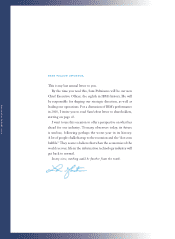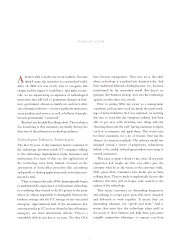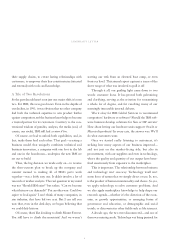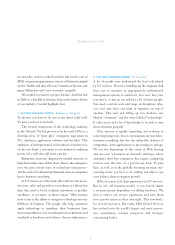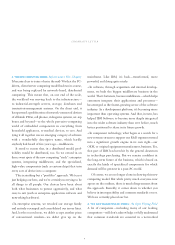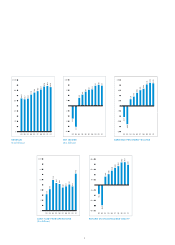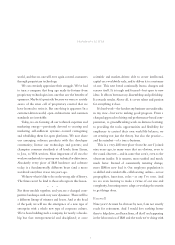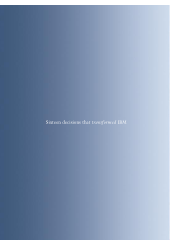IBM 2001 Annual Report Download - page 5
Download and view the complete annual report
Please find page 5 of the 2001 IBM annual report below. You can navigate through the pages in the report by either clicking on the pages listed below, or by using the keyword search tool below to find specific information within the annual report.3
its own sake, and was either buried in labs (in the case of
IBM), or generating premature visions of business triumph
(in the “build it and they will come” fantasies of the dot-com
paper billionaires and “new economy” moguls).
We needed to reassert a proper balance. And that led,
in IBM, to a handful of strategic bets on the future drivers
of our industry. I would highlight four.
1.THE NEW INDUSTRY MODEL:Innovate or Integrate
To survive, you have to do one or the other really well.
To lead, you have to do both.
The vertical integration of the technology industry
in the ’60s and ’70s had given way by the early 1990s to a
dizzying array of “pure play” companies (specialists in
PCs, databases, application software and the like). This
explosion of entrepreneurial and technical creativity was,
on the one hand, a testament to our industry’s enduring
power. It’s a well that will never run dry.
Businesses, however, desperately needed someone to
help them make sense of this chaos. Hence, the emergence
over the past several years of technology integrators
—
and the rush of traditional professional services companies
into e-business consulting.
As I/T moves out of the back office and into the execu-
tive suite, value and growth in our industry are driven less
than they used to be by technical innovation or product
excellence, as necessary as those remain. What matters
most today is the ability to integrate technology into the
lifeblood of business. The people who help customers
apply technology to transform their businesses have
increasing influence over everything from architecture and
standards to hardware and software choices and partners.
2.THE NEW BUSINESS MODEL: Services-Led
A lot of people now understand the lead role played
by I/T services. However, building up the requisite skill
base, not to mention an appropriately sophisticated
management system, is nontrivial. You can’t buy your
way into it, or just go out and hire a lot of smart people.
You need a certain scale and range of disciplines. Also,
you can’t just layer one kind of expertise on top of
another. This isn’t just filling up two beakers, one
labeled “customer” and the other labeled “technology.”
It takes years and a lot of knowledge to be able to mix
those elements properly.
Plus, services is rapidly expanding and evolving in
some surprising ways. It now encompasses not just labor-
intensive consulting, but also the utility-like delivery of
computing
—
from applications, to processing, to storage.
We see the beginnings of this trend in Web hosting
and our own “e-business on demand” offerings, where
customers don’t buy computers, but acquire computing
services over the Net, on a pay-for-use basis. To play
here, as well as in the globally booming strategic out-
sourcing arena, you have to be willing and able to use
your balance sheet to support growth.
IBM, of course, had deep experience in I/T services.
But in our old business model, it was buried inside
a revenue stream dependent on selling hardware. We
had to extract our service operations and turn them
into a profit center in their own right. That involved a
lot of trial and error. But today, IBM Global Services
has evolved into the world’s largest and most innova-
tive consultancy, systems integrator and strategic
outsourcing leader.
chairman’s letter

